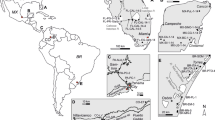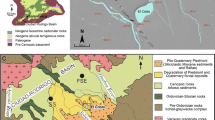Abstract
We quantified differences in oxygen isotope fractionation among three biostratigraphically important subfossil ostracod species (Metacypris cordata, Pseudocandona rostrata and Candonopsis kingsleii) from an early Holocene freshwater tufa layer in northern Estonia. Estimated mean δ18O values are −10.05‰ for M. cordata, −9.34‰ for C. kingsleii and −8.75‰ for P. rostrata. All three species exhibit positive offset from the weighted mean annual δ18O of contemporary precipitation (−10.7‰ in δ18OV-PDB) and from the mean δ18O value of authigenic tufa carbonate (−10.64‰) in the ostracod-bearing layer. Assuming that the known oxygen isotope fractionation in P. rostrata (+2.5‰) and M. cordata (+1.5‰) has remained constant over time, the theoretical δ18OV-SMOW of the early Holocene lake water was calculated to have been between −11.52 and −11.92‰, slightly less negative than the local Ordovician groundwater (−11.7 to −12.2‰). δ18O values of the tufa carbonate differ by +0.6 to +1.0‰ from the calculated theoretical isotope composition (δ18OV-PDB) of lake water, indicating that the tufa also did not precipitate in isotopic equilibrium with ambient waters. Results show that the greater the δ18O offset from the calculated, theoretical isotope composition of lake water for an ostracod species, the lower is its preferred mean July temperature. Both our data and earlier published results on δ18O values in Holocene lacustrine carbonates and ostracods from north-eastern Europe, display pronounced decreases in δ18O with an increase in latitude of the study site. This suggests that temperature-dependent, and therefore latitude-dependent isotopic composition of meteoric waters controlled the δ18O values in lacustrine tufa and ostracods throughout the Holocene.







Similar content being viewed by others
References
Arold I (2005) Eesti maastikud. Tartu Ülikooli Kirjastus, Tartu, pp 35–38
Bartosh T (1967) Holocene fresh-water carbonic sediments of the European part of USSR. In: Kalesnik S, Kvasov D (eds) The history of the lakes in the North-West. Geographical Society of USSR, Leningrad, pp 261–265
Bartosh T (1976) Process of carbonate accumulation and stratigraphic position of carbonate deposits in Holocene section of the European part of the USSR. In: Bartosh T, Kabailene M, Raukas A (eds) Palynology in continental and marine geologic investigations. Zinatne Publishers, Riga, pp 23–46
Bernasconi S, McKenzie J (2007) Lake sediments. In: Elias SA (ed) Encyclopedia of quaternary science, 1. Elsevier, Amsterdam, pp 351–359
Bronk Ramsey C (1995) Radiocarbon calibration and analysis of stratigraphy: the OxCal program. Radiocarbon 37:425–430
Bronk Ramsey C (2001) Development of the radiocarbon program OxCal. Radiocarbon 43:355–363
Danielopol DL, Vespremeanu EE (1964) The presence of ostracods on floating fen soil in Rumania. Fragmenta Balcanica Musei Macedonici Scientiarum Naturalium 7:29–36
Danieolopol DL, Horne DJ, Wood RN (1996) Notes on the ecology of Metacypris cordata (Ostracoda, Timiriaseviinae). In: Keen MC (ed) Proceedings of the 2nd European ostracodologists meeting. British micropalaeontological society, London, pp 175–179
Dansgaard W (1964) Stable isotopes in precipitation. Tellus 16:436–468
Dettman DL, Smith AJ, Rea DK, Moore TC, Lohmann KC (1995) Glacial meltwater in Lake Huron during early postglacial time as inferred from single valve analysis of oxygen isotopes in ostracodes. Quat Res 43:297–310
EE (2002) Eesti Entsüklopeedia, Eesti üld, 11. Eesti Entsüklopeediakirjastus, Tallinn, p 114
Filippi ML, Lambert P, Hunziker J, Kübler B, Bernasconi S (1999) Climatic and anthropogenic influence on the stable isotope record from bulk carbonates and ostracodes in Lake Neuchâtel, Switzerland, during the last two millennia. J Paleolimnol 21:19–34
Garnett ER, Andrews JE, Preece RC, Dennis PF (2004) Climatic change recorded by stable isotopes and trace elements in a British Holocene tufa. J Quat Sci 19:251–262
Gedda B (2001) Environmental and climatic aspects of the early to mid Holocene calcareous tufa and land mollusc fauna in southern Sweden. Lundqua thesis 45, 50 pp
Griffiths HI, Holmes JA (2000) Non-marine ostracods and Quaternary palaeoenvironments. Technical Guide 8, Quaternary Research Association, London 188 pp
Hammarlund D, Edwards TWD, Björk S, Buchardt B, Wohlfarth B (1999) Climate and environment during the Younger Dryas (GS-1) as reflected by composite stable isotope records of lacustrine carbonates at Torreberga, southern Sweden. J Quat Sci 14:17–28
Hammarlund D, Barnekow L, Birks HJB, Buchardt B, Edwards TWD (2002) Holocene changes in atmospheric circulation recorded in the oxygen-isotope straigraphy of lacustrine carbonates from northern Sweden. Holocene 12:339–351
Heikkilä M, Seppä H (2003) A 11, 000 y palaeotemperature reconstruction from the southern boreal zone in Finland. Quat Sci Rev 22:541–554
Henderson A, Holmes J, Zhang J, Leng M, Carvalho L (2003) A carbon- and oxygen-isotope record of recent environmental change from Qinghai Lake, NE Tibetan Plateau. Chin Sci Bull 48:1463–1468
Hiller D (1972) Untersuchungen zur biologie und zur ökologie limnischer ostracoden aus der umgebung von Hamburg. Arch Hydrobiol 4:400–497
Holmes JA, Chivas AR (2002) Ostracod carapace chemistry–overview. In: Holmes JA, Chivas AR (eds) The ostracoda: applications in quaternary research. Geophysical monograph 131. American Geophysical Union, 185–203
Hori M, Hoshino K, Okumura K, Kano A (2008) Seasonal patterns of carbon chemistry and isotopes in tufa depositing groundwaters of southwestern Japan. Geochim Cosmochim Acta 72:480–492
Horne D (2007) A mutual temperature range method for quaternary palaeoclimatic analysis using European nonmarine Ostracoda. Quat Sci Rev 26:1398–1415
Hut G (1987) Consultant’s group meeting on stable isotope reference samples of geochemical and hydrological investigations. IAEA, Vienna, p 42 Report to the Director General
Ito E, De Deckker P, Eggins SM (2003). Ostracodes and their carapace chemistry: implications for paleohydrologic and paleoclimatologic applications. In: Park LE, Smith AJ (eds) Bridging the Gap. Trends in the ostracod biological and geological sciences, vol 9. The paleontological society papers, pp 119–150
Järvekülg A (2001) Eesti jõed. Tartu Ülikooli Kirjastus, Tartu, p 750
Kalm V (2006) Pleistocene chronostratigraphy in Estonia, southeastern sector of the Scandinavian glaciation. Quat Sci Rev 25:960–975
Keatings KW, Heaton THE, Holmes JA (2002a) Carbon and oxygen isotope fractionation in non-marine ostracods: Results from a ‘nature culture’ environment. Geochim Cosmochim Acta 66:1701–1711
Keatings KW, Heaton THE, Holmes JA (2002b) The effects of diagenesis on the trace element and stable isotope geochemistry of non-marine ostracod valves. J Paleolimnol 25:245–252
Kim ST, O′Neil JR (1997) Equilibrium and nonequilibrium oxygen isotope effects in synthetic carbonates. Geochim Cosmochim Acta 61:3461–3475
Kink H (2006) Veeobjektid Eesti ürglooduse raamatus. Teaduste Akadeemia Kirjastus, Tallinn, p 144
Kirby M, Patterson W, Mullins H, Burnett A (2002) Post-Younger Dryas climate interval linked to circumpolar vortex variability: isotopic evidence from Fayetteville Green Lake, New York. Climate Dynamics 19:321–330
Leng M, Marshall J (2004) Palaeoclimate interpretation of stable isotope data from lake sediment archives. Quat Sci Rev 23:811–831
Lister GS (1988) A 15, 000 year record from Lake Zürich of deglaciation and climatic change in Switzerland. Quat Res 29:129–141
Makhnach N, Zernitskaja V, Kolosov I, Simakova G (2004) Stable oxygen and carbon isotopes in Late Glacial-Holocene freshwater from Belarus and their palaeoclimatic implications. Palaeogeogr Palaeoclimatol Palaeoecol 209:73–101
Mäemets A (1977) Eesti NSV järved ja nende kaitse. Valgus, Tallinn, p 263
Männil R (1964) Järvelubja lasundite levik ja stratigraafia. Dissertatsioon. ENSV Teaduste Akadeemia Geoloogia Instituut, Tallinn, pp 141–149
Martma T (1988) Izotopnoe ravnovesie sistemy CO2–HCO3 −–CO3 2− v nekatoryh ozerah severo-vostočnoj Estonji. Izotopno-geohimičeskie issledovanija v Pribaltike i Belorussii. Akademija nauk Estonskoi SSR, Institut Geologii, 117–124 (in Russian)
Meisch C (2000) Freshwater ostracoda of western and central Europe. Süßwasserfauna von Mitteleuropa 8/3. Spektrum, Heidelberg 522 pp
Niinemets E (1999) Lake Peipsi: palaeoecological and palaeoclimatic interpretations on ostracod data. Msc Thesis. University of Tartu, 76 pp
Pazdur A (1988) The relations between carbon isotope composition and apparent age of freshwater tufaceous sediments. Radiocarbon 30:7–18
Pazdur A, Pazdur MF (1990) Further investigations on 14C dating of calcareous tufa. Radiocarbon 32:17–22
Pentecost A, Thorpe P, Harkness D, Lord T (1990) Some radiocarbon dates for tufas of the Craven district of Yorkshire. Radiocarbon 32:93–97
Punning JM, Toots M, Vaikmäe R (1987) Oxygen-18 in estonian natural waters. Isotopenpraxis 23:232–234
Punning JM, Koff T, Martma T, Possnert G (2002) Stable isotope and pollen stratigraphy in marl sediments from Lake Ilmjärv (central Estonia). Proc Estonian Acad Sci Geol 51:180–192
Punning JM, Kangur M, Koff T, Possnert G (2003) Holocene lake/level changes and their reflection in the paleolimnological records of two lakes in northern Estonia. J Paleolimnol 29:167–178
Raukas A, Saarse L, Veski S (1995) A new version of the Holocene stratigraphy in Estonia. Proc Estonian Acad Sci Geol 44:201–210
Rosentau A, Vassiljev J, Hang T, Saarse L, Kalm V (2009) Development of the Baltic Ice Lake in eastern Baltic, Quaternary International, doi:10.1016/j.quaint.2008.10.005
Saarse L, Heinsalu A, Veski S (1995) Palaeoclimatic interpretation of the Holocene litho-and biostratigraphic proxy data from Estonia. In: Heikinheimo P (ed) International conference on past, present and future climate. Painatukeskus OY, Helsinki, pp 102–105
Schmied A (1996) Põhjavee temperatuuri muutused. In: Savitskaja L (ed) Põhjavee seisund 1995. aastal. Eesti Geoloogiakeskus, Tallinn, pp 81–83
Schwalb A, Dean WE (2002) Reconstruction of hydrological changes and response to effective moisture variations from North-Central USA lake sediments. Quat Sci Rev 21:1541–1554
Seppä H, Poska A (2004) Holocene annual mean temperature changes in Estonia and their relationship to solar insolation and atmospheric circulation patterns. Quat Res 61:22–31
Sohar K, Kalm V (2008) 12.8 ka long palaeoenvironmental record revealed by subfossil ostracod data from lacustrine freshwater tufa in Lake Sinijärv, northern Estonia. J Paleolimnol 40:809–821
Teranes JL, McKenzie JA, Bernasconi ST, Lotter AF, Sturm M (1999) A study of oxygen isotopic fractionation during bio-induced calcite precipitation in eutrophic Baldeggersee, Switzerland. Geochim Cosmochim Acta 63:1981–1989
Vaikmäe R, Vallner L, Loosli HH, Blaser PC, Juillard-Tardent M (2001) Paleogroundwater of glacial origin in the Cambrian-Vendian aquifer of northern Estonia. In: Edmunds WM, Milne SJ (eds) Palaeowaters in coastal Europe: evolution of groundwater since the late Pleistocene. Geological Society, London, Special Publications 189:17–27
Von Grafenstein U, Erlenkeuser H, Kleinmann A, Müller J, Trimborn P (1994) High-frequency climatic oscillations during the last deglaciation as revealed by oxygen-isotope records of benthic organisms (Ammersee, southern Germany). J Paleolimnol 11:349–357
Von Grafenstein U, Erlenkeuser H, Brauer A, Jouzel J, Johnsen SJ (1999) Oxygen and carbon isotopes in modern fresh-water ostracod valves: assessing vital offsets and autecological effects of interest for palaeoclimate studies. Palaeogeogr Palaeoclimatol Palaeoecol 148:133–152
Wetterich S, Schirrmeister L, Meyer H, Viehberg FA, Mackensen A (2008) Arctic freshwater ostracods from modern periglacial environments in the Lena River Delta (Siberian Arctic, Russia): geochemical applications for palaeoenvironmental reconstructions. J Paleolimnol 39:427–449
Xia J, Ito E, Engström DR (1997a) Geochemistry of ostracode calcite: Part 1. An experimental determination of oxygen isotope fractionation. Geochim Cosmochim Acta 61:377–382
Xia J, Engstrom DR, Ito E (1997b) Geochemistry of ostracode calcite: Part 2. The effects of water chemistry and seasonal temperature variation on Candona rawsoni. Geochim Cosmochim Acta 61:383–391
Acknowledgments
We thank the Iso-Analytical Ltd Laboratory, UK, for oxygen and carbon isotope analyses, the Poznań Radiocarbon Laboratory, Poland, for AMS dating and the Tartu Radiocarbon Dating Laboratory for conventional radiocarbon dating. K. Lasberg and L. Laumets provided field assistance and H. Sepp did LOI measurements. This work was co-funded by Estonian State Research Foundation projects No. 018004s08 and 0180051s08, and Estonian Science Foundation project No. 7563. We appreciate the suggestions and constructive criticism of two reviewers.
Author information
Authors and Affiliations
Corresponding author
Rights and permissions
About this article
Cite this article
Kalm, V., Sohar, K. Oxygen isotope fractionation in three freshwater ostracod species from early Holocene lacustrine tufa in northern Estonia. J Paleolimnol 43, 815–828 (2010). https://doi.org/10.1007/s10933-009-9370-3
Received:
Accepted:
Published:
Issue Date:
DOI: https://doi.org/10.1007/s10933-009-9370-3




